The Saint of the Day
 |
 |
 |
 |
 |
 |
 |
St. Tarasius - February 25
Biographical selection:
Tarasius (730-806) had as special mission to prevent the iconoclast heresy from prevailing in the East. His father was one of the first magistrates of the Empire and his mother a person of great virtue. Both taught him to remain faithful to the Truth. Even though he did not dissimulate his beliefs, he was made consul and then minister of Empress Irene, who governed during the minority of her son Constantine.
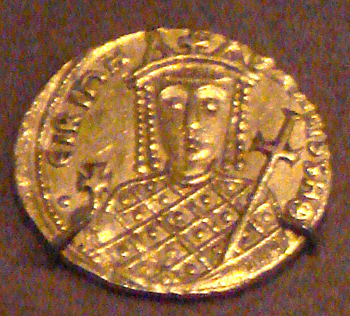 The See of Constantinople was occupied by Paul IV, a man whose weakness made him fall into heresy. He was Catholic in the depth of his heart, but, fearing to displease the court, had favored the iconoclasts. However, when he fell prey to a mortal disease, he finally remembered that it was time to show some courage if he did not want to be condemned to Hell. He renounced the Patriarchate in 784, left the palace and went to a monastery in Constantinople, where he became a monk.
The See of Constantinople was occupied by Paul IV, a man whose weakness made him fall into heresy. He was Catholic in the depth of his heart, but, fearing to displease the court, had favored the iconoclasts. However, when he fell prey to a mortal disease, he finally remembered that it was time to show some courage if he did not want to be condemned to Hell. He renounced the Patriarchate in 784, left the palace and went to a monastery in Constantinople, where he became a monk.
Empress Irene, who had great confidence in him, went there to ask him to return to head the See.
“I wish that I had never occupied that See, my Lady,” he said, weeping, “with the Church oppressed, separated from the others and anathematized. If an ecumenical council is not gathered to correct the error that reigns here, there is no longer salvation for us.”
The Empress asked: “Why, then, did you agree to the prohibition to honor the statues when you were elected?”
The Patriarch: “This is what I deplore and the reason for the penance I make now. May God forgive me for not have preached the truth to you, I who am your Bishop, for fear of your ire. For, had death come to surprise me in that See that receives of all the anathemas of the Catholic Church, I would have fallen into the darkness of Hell.”
The Empress asked him who could replace him, and he gave the name of Tarasius as one highly worthy of that position.
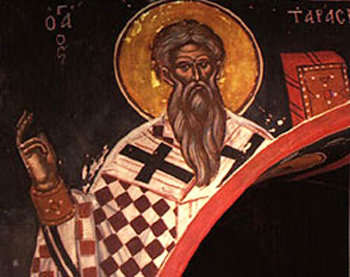 But Tarasius did not accept, alleging two reasons: He was a layman and Constantinople was separated from Rome and anathematized. He concluded: “If a council is called to reestablish the unity, I will submit to the will of God. If not, I do not want to be condemned on the day of the judgment, when no Emperor, Bishop, Magistrate or multitude could free me from the vengeance of God.”
But Tarasius did not accept, alleging two reasons: He was a layman and Constantinople was separated from Rome and anathematized. He concluded: “If a council is called to reestablish the unity, I will submit to the will of God. If not, I do not want to be condemned on the day of the judgment, when no Emperor, Bishop, Magistrate or multitude could free me from the vengeance of God.”
Tarasius became Patriarch of Constantinople and the Second Council of Nicaea was called in 787, which rejected iconoclasm. Union with the Roman Church was restored.
As Patriarch, Tarasius gave the best example of virtue, fighting particularly against the moral misbehavior of the Emperors and the court. He died at the age of 76 on February 25 of the year 806.
Fourteen years after his death, Emperor Leo the Armenian reignited the iconoclast heresy and was persecuting the Church. In his dreams he saw St. Tarasius sternly giving an order to a man: “Michael, kill him!” And then that man ran the Sovereign through with a sword.
The Emperor went to the monastery of St. Tarasius and looked for a monk with this name in order to arrest and execute him immediately. He submitted some monks to torture but they insisted that no one in the monastery had that name.
Six days later, the Emperor was assassinated by the partisans of one of his counselors, Michael the Amorian, who succeeded him on the throne.
Comments of Prof. Plinio:
This biography stresses three points: first, the horrible position of the Patriarch Paul of Constantinople, second, the greatness of St. Tarasius who succeeded him and third, the chastisement of the Emperor Leo the Armenian.
1 - The situation of that Patriarch was horrible because he had faith and in fact had no sympathy for the iconoclast heresy, but he supported it. He was an opportunist who occupied the office to take advantage of it. In those times that office had an enormous importance. Moved by a vile opportunism, he pretended that he did not know it was a heretical doctrine.
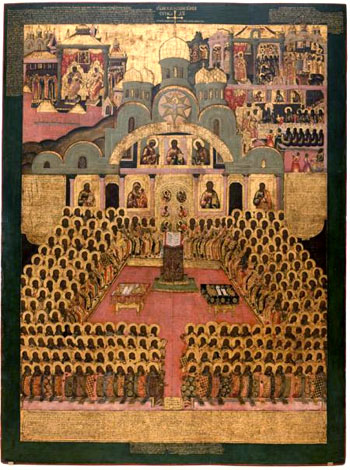 Finally, when the moment of his death approached, he at least had the fear of Hell. The love of God did not move him, but the realization that he could go to Hell moved him. Even here, his position was weak, for if he were to repair the evil he had done, he should have remained in the episcopal palace. There, even if he were very ill, he should have used the rest of his days to undo the evil he had done. We see that he did not do this for fear of persecution. Therefore, he made a pitiful decision, left the Patriarchate, went to a monastery and there prepared himself to die.
Finally, when the moment of his death approached, he at least had the fear of Hell. The love of God did not move him, but the realization that he could go to Hell moved him. Even here, his position was weak, for if he were to repair the evil he had done, he should have remained in the episcopal palace. There, even if he were very ill, he should have used the rest of his days to undo the evil he had done. We see that he did not do this for fear of persecution. Therefore, he made a pitiful decision, left the Patriarchate, went to a monastery and there prepared himself to die.
There was at least one redeeming thing in the abyss of the sin he had fallen into: He had not committed the sin of sympathizing with the iconoclast doctrine. He did not hate those errors as he should have, but at least he was concerned for the salvation of his own soul.
When the Empress went to the monastery to invite him to return, he humbly confessed the evil he had done, and then confessed the wrong stance he had taken. Doing so, he prepared the spirit of the Empress to accept a successor who could repair the situation. The Empress asked him to name an orthodox successor and he gave.
That man was St. Tarasius, a man who governed the See of Constantinople for a long time with energy. It was to St. Tarasius that Constantinople owes it reunion with the Catholic Church. What do we see here? That a man can greatly fall, but Divine Goodness will show him an extraordinary forgiveness so long as he did not sympathize with the evil.
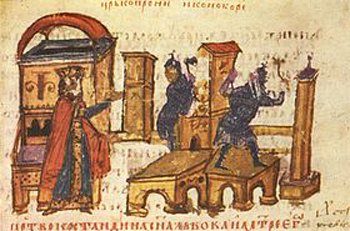 Today we see many persons doing what this Patriarch did, but they die unrepentant. We don’t know a case of a progressivist, a Teilhard de Chardin, who did to the world much greater evil than that heretical Patriarch, who repented before dying. It is because they sinned against the spirit, they loved the Revolution, which they served so well. Thus, we do not know of one of them who repented at the hour of death.
Today we see many persons doing what this Patriarch did, but they die unrepentant. We don’t know a case of a progressivist, a Teilhard de Chardin, who did to the world much greater evil than that heretical Patriarch, who repented before dying. It is because they sinned against the spirit, they loved the Revolution, which they served so well. Thus, we do not know of one of them who repented at the hour of death.
Here we understand how today’s sins are worse than the sins of yesterday, and how the Devil victory is more complete with the total self-delivery these souls make to him.
2 - Then, we have the other aspect, which is the very beautiful life of St. Tarasius. It causes us great joy to imagine his long pontificate in the Church of the East, which was a sort of branch almost completely detached from the tree that was the Catholic Church. After him, the Faith bloomed, the iconoclasts were persecuted, the rich treasure of Eastern piety started to be reanimated again by Catholic sap. All these facts are so pleasant to recall, and so simple to be reconstituted by the imagination that we cannot do other thing than to pass over them.
3 - Now, the last part regards the chastisement of the Emperor. After the death of St. Tarasius, an iconoclast Emperor came to the throne and reestablished the iconoclast heresy and had a dream. In the miraculous dream he received a threat, which was accomplished. A certain Michael sent by St. Tarasius executed his order and killed the Emperor.
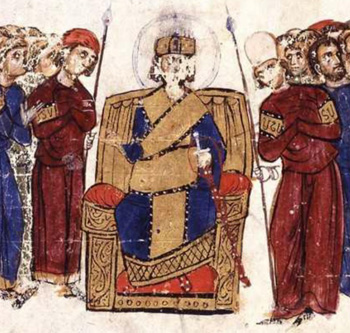
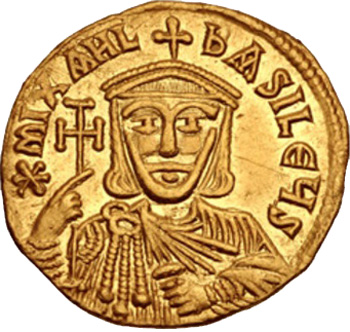 We see in this episode another miracle, that is, the bad Emperor believed the dream. Today, we do not see people believing in prophecies revealing chastisements. Heaven spoke in La Salette, Heaven spoke again in the secret Our Lady revealed to St. Bernadette in Lourdes, Heaven clearly spoke in Fatima. But those secrets were not revealed. Heaven’s voice was muffled; there was no
imprimatur for Heaven. The result we are seeing: The salutary threats that could have saved mankind were ignored…
We see in this episode another miracle, that is, the bad Emperor believed the dream. Today, we do not see people believing in prophecies revealing chastisements. Heaven spoke in La Salette, Heaven spoke again in the secret Our Lady revealed to St. Bernadette in Lourdes, Heaven clearly spoke in Fatima. But those secrets were not revealed. Heaven’s voice was muffled; there was no
imprimatur for Heaven. The result we are seeing: The salutary threats that could have saved mankind were ignored…
By this fact we can see the immensity of this sin. An Emperor believed in the threat he received, believed that a Saint was threatening him and tried to find and kill the one who would be the instrument of his death. But at least he made his intent known, and others could give glory to God for His work of justice. Today, no one knows anything; nothing happens.
How much worse the sin of the Revolution is than the sins that preceded it! How it communicates to souls a much more grave malice that makes the same sin worse now than it was then!
It is good for us to understand this point very well: for a sin without precedent, a chastisement without precedent. In that time the evil could be stopped by St. Tarasius sending a man to kill the Emperor. Today, an individual solution is not enough. The only way out is Divine Providence calling upon Itself the task of punishing mankind. From here comes to mind the strong, coherent, serene conviction that the Chastisement will come.
I see in the gesture of St. Tarasius, in the fact that he appeared to the Emperor to put fear in him something that reflects the depths of my soul.
I wish that after my death I could do something similar to what St. Tarasius did: To spend my Heaven until the end of the world appearing to the leaders of the Revolution, threatening them, causing them panic and bewildering their plans. After the sin of the Revolution, nothing could better glorify Heavens than spreading panic among the evil ones on earth.


The Saint of the Day features highlights from the lives of saints based on comments made by the late Prof. Plinio Corrêa de Oliveira. Following the example of St. John Bosco who used to make similar talks for the boys of his College, each evening it was Prof. Plinio’s custom to make a short commentary on the lives of the next day’s saint in a meeting for youth in order to encourage them in the practice of virtue and love for the Catholic Church. TIA thought that its readers could profit from these valuable commentaries.
The texts of both the biographical data and the comments come from personal notes taken by Atila S. Guimarães from 1964 to 1995. Given the fact that the source is a personal notebook, it is possible that at times the biographic notes transcribed here will not rigorously follow the original text read by Prof. Plinio. The commentaries have also been adapted and translated for TIA’s site.
Tarasius (730-806) had as special mission to prevent the iconoclast heresy from prevailing in the East. His father was one of the first magistrates of the Empire and his mother a person of great virtue. Both taught him to remain faithful to the Truth. Even though he did not dissimulate his beliefs, he was made consul and then minister of Empress Irene, who governed during the minority of her son Constantine.

Gold solidus of Empress Irene 780-802
Empress Irene, who had great confidence in him, went there to ask him to return to head the See.
“I wish that I had never occupied that See, my Lady,” he said, weeping, “with the Church oppressed, separated from the others and anathematized. If an ecumenical council is not gathered to correct the error that reigns here, there is no longer salvation for us.”
The Empress asked: “Why, then, did you agree to the prohibition to honor the statues when you were elected?”
The Patriarch: “This is what I deplore and the reason for the penance I make now. May God forgive me for not have preached the truth to you, I who am your Bishop, for fear of your ire. For, had death come to surprise me in that See that receives of all the anathemas of the Catholic Church, I would have fallen into the darkness of Hell.”
The Empress asked him who could replace him, and he gave the name of Tarasius as one highly worthy of that position.

St. Tarasius 730-806
Tarasius became Patriarch of Constantinople and the Second Council of Nicaea was called in 787, which rejected iconoclasm. Union with the Roman Church was restored.
As Patriarch, Tarasius gave the best example of virtue, fighting particularly against the moral misbehavior of the Emperors and the court. He died at the age of 76 on February 25 of the year 806.
Fourteen years after his death, Emperor Leo the Armenian reignited the iconoclast heresy and was persecuting the Church. In his dreams he saw St. Tarasius sternly giving an order to a man: “Michael, kill him!” And then that man ran the Sovereign through with a sword.
The Emperor went to the monastery of St. Tarasius and looked for a monk with this name in order to arrest and execute him immediately. He submitted some monks to torture but they insisted that no one in the monastery had that name.
Six days later, the Emperor was assassinated by the partisans of one of his counselors, Michael the Amorian, who succeeded him on the throne.
Comments of Prof. Plinio:
This biography stresses three points: first, the horrible position of the Patriarch Paul of Constantinople, second, the greatness of St. Tarasius who succeeded him and third, the chastisement of the Emperor Leo the Armenian.
1 - The situation of that Patriarch was horrible because he had faith and in fact had no sympathy for the iconoclast heresy, but he supported it. He was an opportunist who occupied the office to take advantage of it. In those times that office had an enormous importance. Moved by a vile opportunism, he pretended that he did not know it was a heretical doctrine.

The Second Council of Nicaea (787) was called to restore the union with Rome & the use of icons
There was at least one redeeming thing in the abyss of the sin he had fallen into: He had not committed the sin of sympathizing with the iconoclast doctrine. He did not hate those errors as he should have, but at least he was concerned for the salvation of his own soul.
When the Empress went to the monastery to invite him to return, he humbly confessed the evil he had done, and then confessed the wrong stance he had taken. Doing so, he prepared the spirit of the Empress to accept a successor who could repair the situation. The Empress asked him to name an orthodox successor and he gave.
That man was St. Tarasius, a man who governed the See of Constantinople for a long time with energy. It was to St. Tarasius that Constantinople owes it reunion with the Catholic Church. What do we see here? That a man can greatly fall, but Divine Goodness will show him an extraordinary forgiveness so long as he did not sympathize with the evil.

The Emperor gives the order to destroy icons
Here we understand how today’s sins are worse than the sins of yesterday, and how the Devil victory is more complete with the total self-delivery these souls make to him.
2 - Then, we have the other aspect, which is the very beautiful life of St. Tarasius. It causes us great joy to imagine his long pontificate in the Church of the East, which was a sort of branch almost completely detached from the tree that was the Catholic Church. After him, the Faith bloomed, the iconoclasts were persecuted, the rich treasure of Eastern piety started to be reanimated again by Catholic sap. All these facts are so pleasant to recall, and so simple to be reconstituted by the imagination that we cannot do other thing than to pass over them.
3 - Now, the last part regards the chastisement of the Emperor. After the death of St. Tarasius, an iconoclast Emperor came to the throne and reestablished the iconoclast heresy and had a dream. In the miraculous dream he received a threat, which was accomplished. A certain Michael sent by St. Tarasius executed his order and killed the Emperor.

Emperor Leo the Armenian, above, was killed by the partisans of Michael the Amorian, below

By this fact we can see the immensity of this sin. An Emperor believed in the threat he received, believed that a Saint was threatening him and tried to find and kill the one who would be the instrument of his death. But at least he made his intent known, and others could give glory to God for His work of justice. Today, no one knows anything; nothing happens.
How much worse the sin of the Revolution is than the sins that preceded it! How it communicates to souls a much more grave malice that makes the same sin worse now than it was then!
It is good for us to understand this point very well: for a sin without precedent, a chastisement without precedent. In that time the evil could be stopped by St. Tarasius sending a man to kill the Emperor. Today, an individual solution is not enough. The only way out is Divine Providence calling upon Itself the task of punishing mankind. From here comes to mind the strong, coherent, serene conviction that the Chastisement will come.
I see in the gesture of St. Tarasius, in the fact that he appeared to the Emperor to put fear in him something that reflects the depths of my soul.
I wish that after my death I could do something similar to what St. Tarasius did: To spend my Heaven until the end of the world appearing to the leaders of the Revolution, threatening them, causing them panic and bewildering their plans. After the sin of the Revolution, nothing could better glorify Heavens than spreading panic among the evil ones on earth.

 | |
|
|
The texts of both the biographical data and the comments come from personal notes taken by Atila S. Guimarães from 1964 to 1995. Given the fact that the source is a personal notebook, it is possible that at times the biographic notes transcribed here will not rigorously follow the original text read by Prof. Plinio. The commentaries have also been adapted and translated for TIA’s site.


